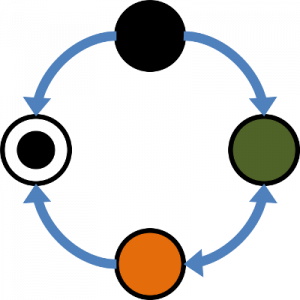Model-based Engineering Methods for Complex Systems Design
This web site references works initiated or maintained at Télécom Paris on Model-based Engineering Methods for Complex Systems Design.
Methods and Tools
Refinement of AADL Models for Synthesis of Embedded Systems (RAMSES)
 RAMSES (Refinement of AADL Models for Synthesis of Embedded Systems) is a model transformation and code generation tool that produces C code for POSIX, ARINC653, or OSEK compliant operating systems. RAMSES, a plugin of OSATE2, proceeds by refinement : it produces refined AADL models as intermediate steps towards code generation. This simplified model includes a behavior annex subclause that expresses the behavior resulting from the expansion of AADL components, connections, and behavior. More information here.
RAMSES (Refinement of AADL Models for Synthesis of Embedded Systems) is a model transformation and code generation tool that produces C code for POSIX, ARINC653, or OSEK compliant operating systems. RAMSES, a plugin of OSATE2, proceeds by refinement : it produces refined AADL models as intermediate steps towards code generation. This simplified model includes a behavior annex subclause that expresses the behavior resulting from the expansion of AADL components, connections, and behavior. More information here.
Requirements Definition and Analysis Language (RDAL)
The Requirements Definition and Analysis Language RDAL is a specification and analysis language providing modeling support of well recognized requirements engineering best practices such as those of the FAA requirement engineering management handbook. RDAL allows to capture requirements and traceability relationships among them (refinement, decomposition, derivation, etc.) and also with system architecture elements of other languages that are intended to satisfy the requirements. RDAL requirements can be expressed with an extensible choice of constraints languages including OCL, which allows their automated verification against the allocated system architecture model. RDAL is a fragment language that has been used for different domains such as embedded systems and Domain-Specific Languages development. RDAL is implemented by the Eclipse-based RDALTE (RDAL Tool Environment) tool, which provides a basic editor for requirements as well as their verification. More information here.
AADL Behavior Annex Editor (AADL-BA-FrontEnd)

AADL-BA-FrontEnd for OSATE 2 is an editor for AADL V2 behavior specifications, integrated and distributed with the reference AADL v2 editor: OSATE 2 (Open Source AADL Tool Environment) developed by the SEI. The behavior specification interpreted by this editor, is defined in the Behavior Model Annex of the AADL V2 standard. This annex was designed to model the behavior of AADL components using state machines. It defines syntactic, semantic, and consistency rules to ensure a given behavior specification is meaningful. The AADL-BA-FrontEnd plug-in checks that a given behavior specification respects these rules. It also implements a data type checker that verifies (according to strict rules close to the Ada type checking) the consistency of data manipulations (assignments, comparison, etc.).
OSATE Declarative-Instance Mapping Tool (OSATE-DIM)

OSATE-DIM is a tool for performing the backward transformation from AADL Instance to Declarative models, known as Deinstantiation. This transformation is the inverse function of the Instantiation forward transformation. The tool is designed to perform incremental backward transformations, to provide maximum information preservation in the AADL model view update problem. Three different de-instantiation commands cover a wide range of user requirements: from the novice, to designer, to developer.
Team Members
Permanent Members
- Laurent Pautet, Professor at Télécom Paris and researcher at LTCI, Télécom Paris, Institut Polytechnique de Paris, France.
- Etienne Borde, Associate Professor at Télécom Paris and researcher at LTCI, Télécom Paris, Institut Polytechnique de Paris, France.
- Dominique Blouin, Researcher Engineer, Télécom Paris, Institut Polytechnique de Paris, France.
Contributors
- Sébastien Gardoll
- Fabien Cadoret
- Cuauhtémoc Castellanos
- Elie Richa
- Smail Rahmoun
- Roberto Medina
- Arthur Remaud
- Ferdinand Lemaire
- Alice Goudout
- Rakshit Mittal
- Vsevolod Omelkov
- Junior Porte